57% of Quiet Quitters Say Their Work-Life Balance Has Improved; For Working Parents With Young Children, It’s Even Higher
Millions of Americans left their jobs in waves during the Great Resignation that began in 2021, but employees now are increasingly choosing not to resign — at least conventionally. Enter quiet quitting, a trend in the workplace power struggle where employees refuse to go above the bare minimum without additional pay.
In this latest LendingTree survey, we asked more than 2,000 U.S. consumers about their experiences with the quiet quitting movement. Here’s what we found.
On this page
Key findings
- 30% of workers consciously participate in quiet quitting, with 57% of these quiet quitters saying their work-life balance has improved. This figure is even higher for working parents with kids younger than 18 at 65%.
- Quiet quitting was happening long before the term became mainstream, with 59% of quiet quitters saying they were already drawing hard lines at work. Only 26% say they started mentally checking out after learning about the term.
- Amid the Great Resignation, quiet quitters are more likely to search for new roles, at 56%. That’s double the rate of the 28% of non-quiet quitters who say the same.
- Although quiet quitters are mentally checking out and/or not taking on more work without compensation, some have trouble cutting back in other realms. 36% of quiet quitters say they work more than their required hours, while 42% don’t use all their paid time off (PTO).
- Setting hard, professional boundaries could fuel positive change. 40% of quiet quitters say they’re more engaged at work than in the past. They cite being very satisfied with their co-workers (30%), boss or manager (25%) and work environment (24%).
Quiet quitters say their work-life balance has improved
The quiet quitting movement is popular with a significant portion of the American workforce: 3 in 10 (30%) workers consciously participate in quiet quitting. Young workers are the most likely to participate, with 40% of Gen Zers ages 18 to 25 identifying as a quiet quitter. That’s followed by:
- 33% of millennials ages 26 to 41
- 24% of Gen Xers ages 42 to 56
- 17% of baby boomers ages 57 to 76
Workers without children are more likely to be quiet quitters, at 33%. Those with children younger than 18 aren’t far behind, though, with 31% participating in the quiet quitting movement. That compares with 20% of workers with adult children.
Quiet quitters seem to benefit from the movement, with 57% saying their work-life balance has improved. This figure is highest among working parents with underage kids, at 65%.
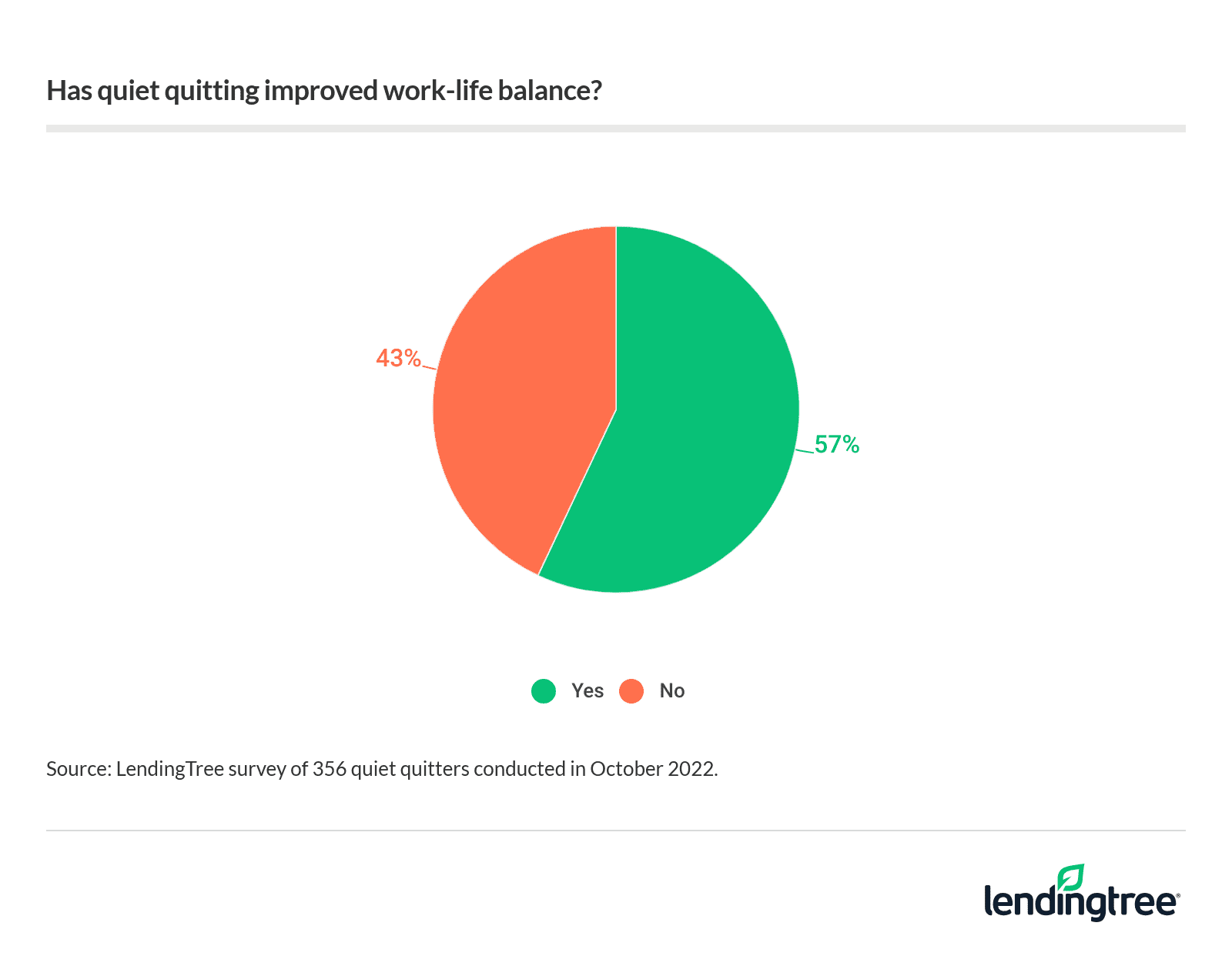
Despite the noticeable benefits, just 22% of workers think the quiet quitting movement is positive. While the majority (49%) of consumers say they’re neutral, 30% think it’s negative.
LendingTree chief credit analyst Matt Schulz says he’s a little surprised that more people view it negatively than positively. Still, he thinks it may stem from the belief that the movement is passive-aggressive.
Gen Z workers are most likely to think the movement is positive (28%), while baby boomers are least likely to say similarly, at 10%. Meanwhile, those who make six figures are the most likely earners to think the movement is negative, at 38%. That compares with 23% of those earning less than $35,000.
Quiet quitting isn’t anything new
Quiet quitting may be a snappy new(ish) term, but the movement itself is anything but. In fact, 59% of quiet quitters say they were already drawing hard lines at work before they’d heard of the term. Only a little over a quarter (26%) say they started mentally checking out after learning about it.
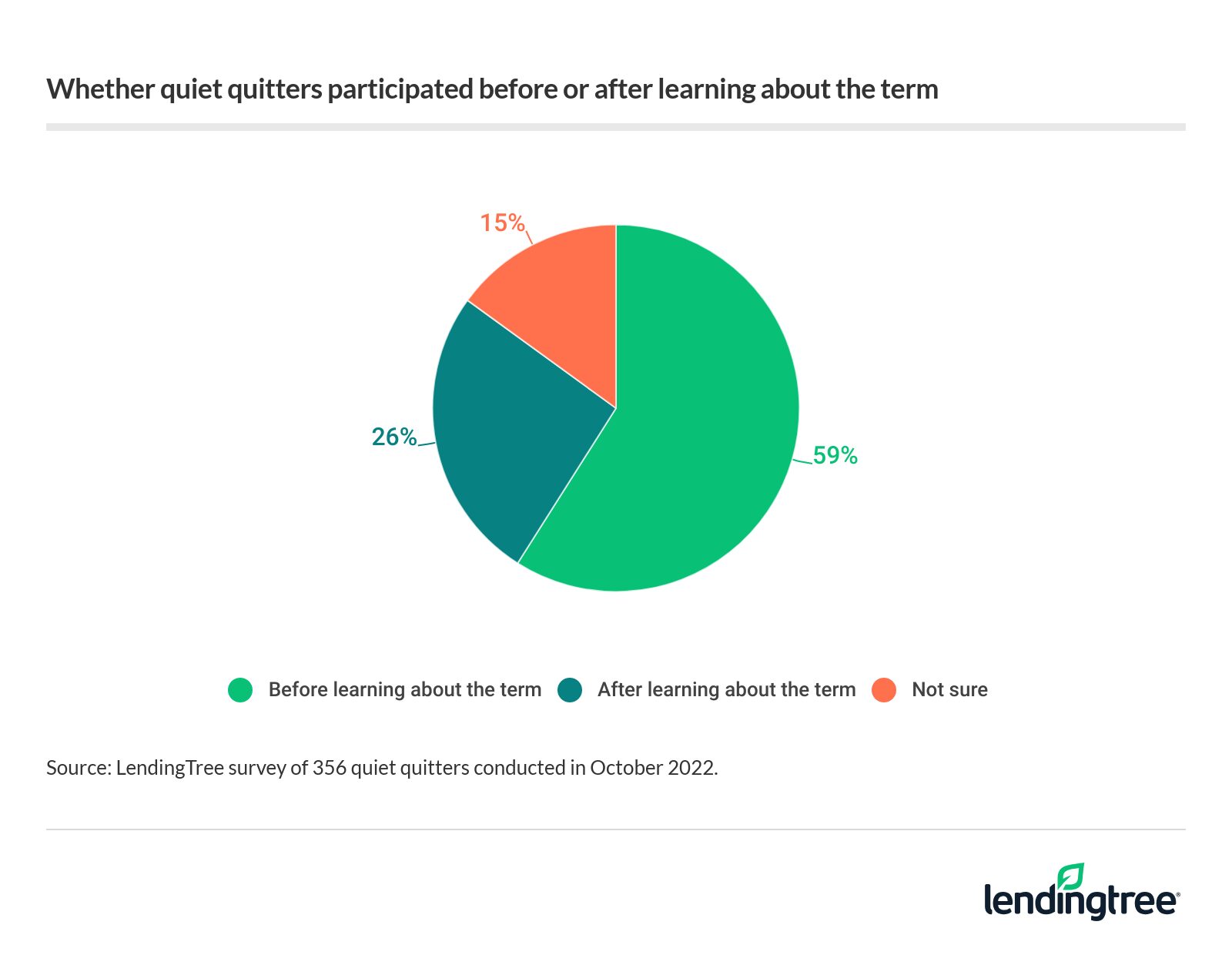
“If someone is quiet quitting, they’re clearly not satisfied with their job,” Schulz says. “If you’re not happy with your job, it’s often only a matter of time before you start mentally checking out or looking for a new one.”
Quiet quitters are more likely to be on the job hunt
The Great Resignation is still alive and well. In total, 36% of workers are actively looking for a new role. But resigning is particularly prevalent among quiet quitters. In fact, 56% of quiet quitters say they’re searching for new roles. Only 28% of non-quiet quitters say the same.
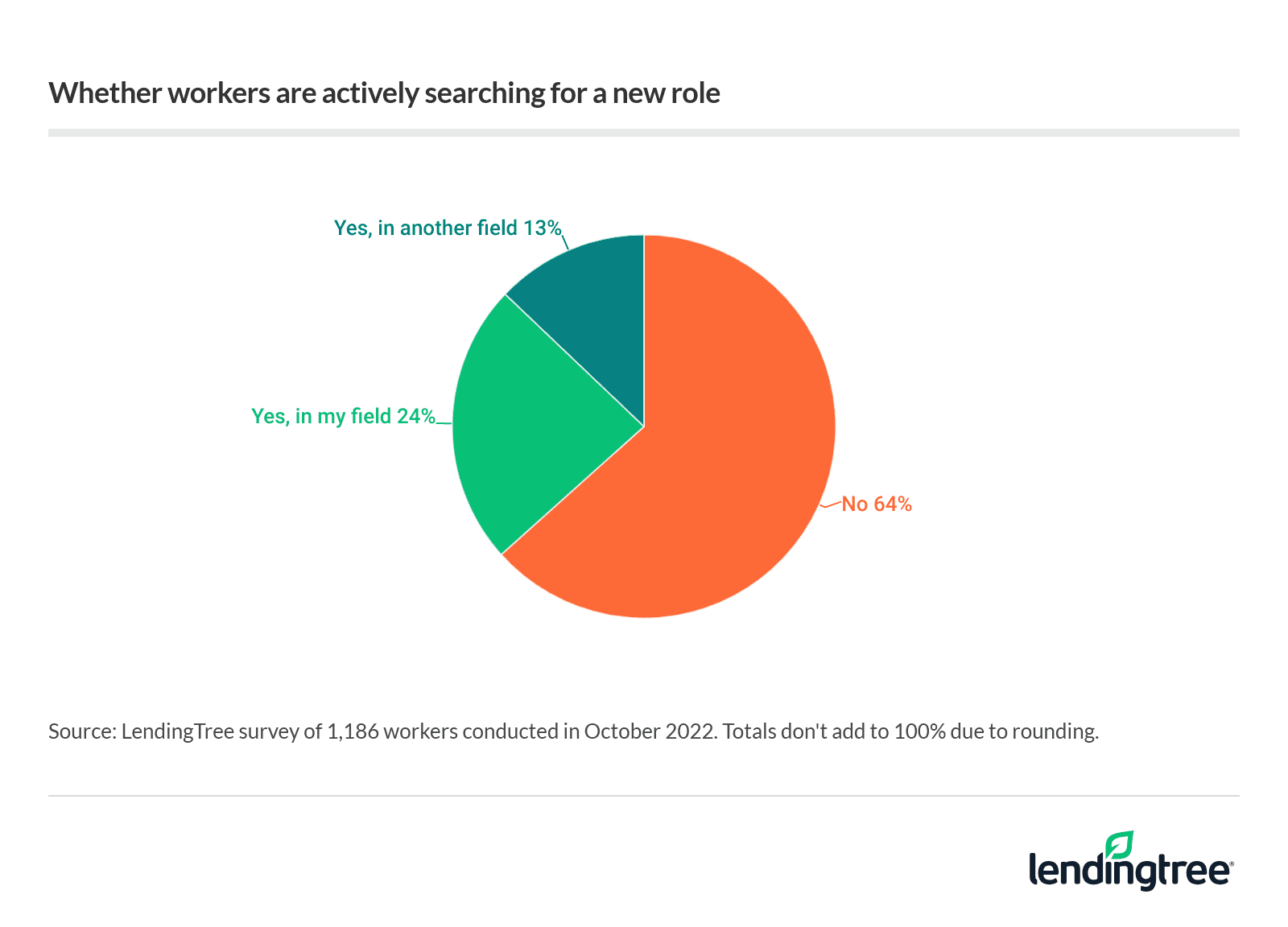
The same groups participating in quiet quitting are also the most likely to seek a new role. Across all workers (not just quiet quitters), Gen Zers are the most likely age group to consider resigning. Of this generation, 47% say they’re actively searching for a new role. That compares with 19% of baby boomers — the least likely group to resign.
In a stark contrast to the Great Resignation, economywide layoffs also have consumers concerned — but quiet quitters are particularly worried that their recent slacking may come back to bite them, as over a quarter (26%) of quiet quitters don’t feel secure in their role. That compares with 15% of workers and 10% of non-quiet quitters.
Regardless of whether they participate in the quiet quitting movement, the lowest-income consumers are also worried about their job security. Among those earning less than $35,000 annually, 21% say they don’t feel secure in their role. Despite being just one pay bump ahead of them, only 11% of those earning between $35,000 and $49,999 say similarly — a difference of 10 percentage points.
Some quiet quitters have trouble cutting back on work
Although they’re only doing what’s expected of them, quiet quitters aren’t exactly twiddling their thumbs all day. Of those participating in the movement, 36% say they work more than their required hours. Comparatively, 42% of non-quiet quitters say similarly.
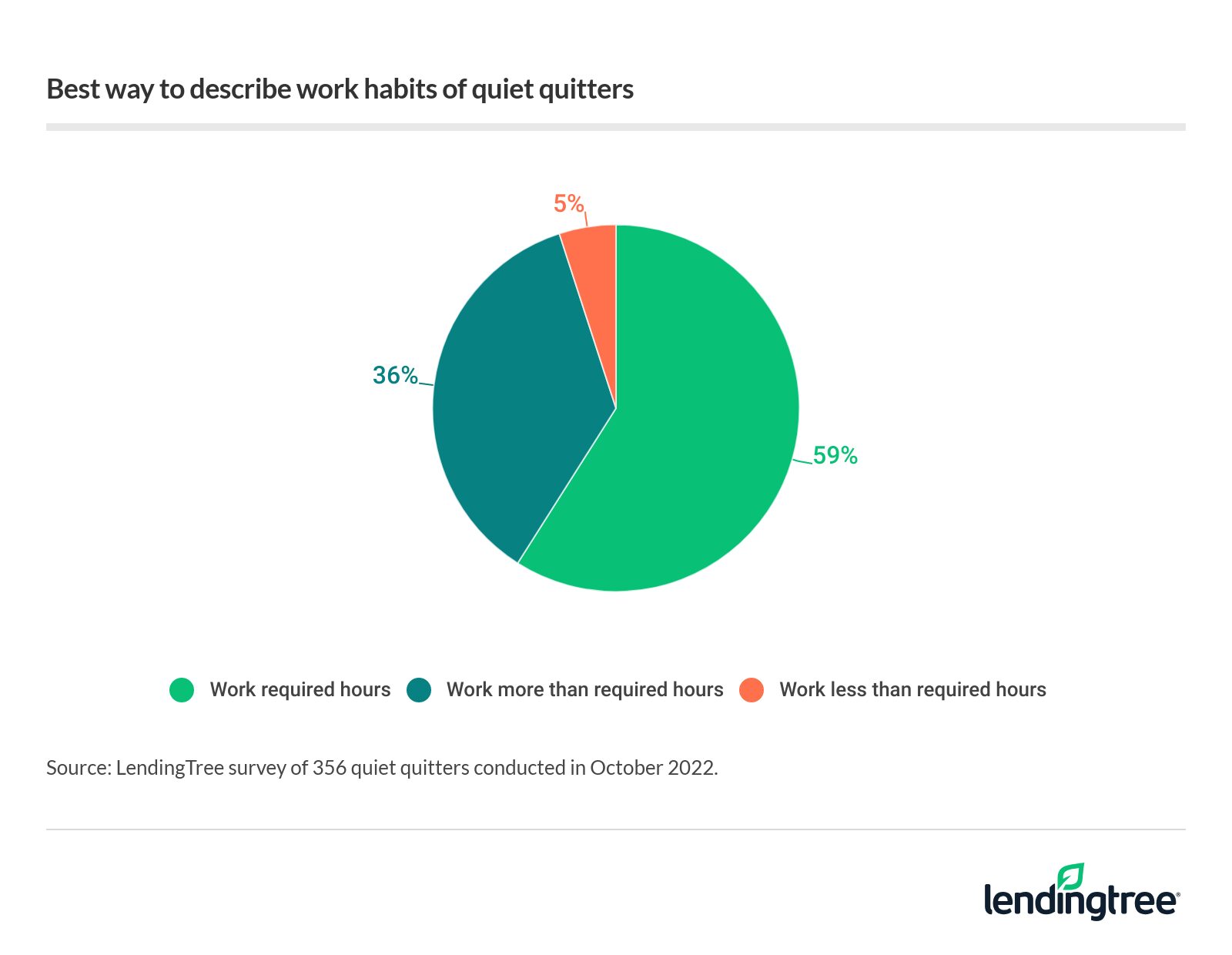
Meanwhile, only 5% of quiet quitters say they work less than their required hours — though that’s still significantly more than the 2% of non-quiet quitters who don’t fill their workday.
Quiet quitters also have trouble taking off work. Across those participating in the movement, 42% don’t use all their paid time off (PTO). That’s an issue across all workers, though. Regardless of whether they participate in the movement, a similar 46% of workers say they only use some or hardly any of their paid time off.
Across all generations, Gen Zers are least likely to not use all their PTO. Quiet quitting or not, 60% of this generation say they don’t use up their PTO. On the other hand, just 38% of baby boomers say similarly.
Setting professional boundaries could play a role in job satisfaction
The quiet quitting movement is rooted in setting professional boundaries, and the data indicates that it may work — at least in some ways. Among quiet quitters, 40% say they’re more engaged at work than in the past. Quiet quitters are most likely to cite being very satisfied with their co-workers (30%), boss or manager (25%) and work environment (24%).
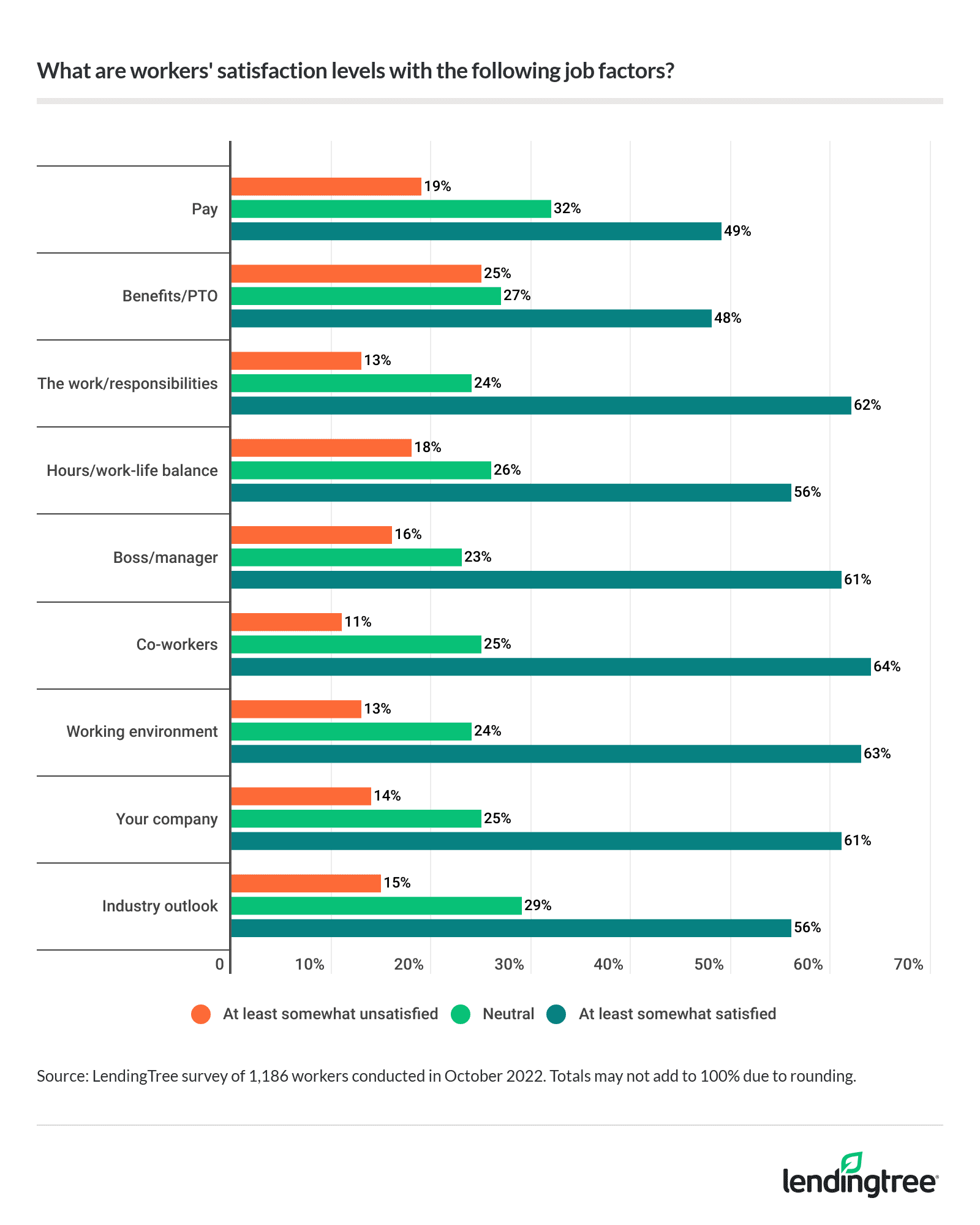
Regardless of whether they participate in the quiet quitting movement, workers feel least satisfied with their pay and benefits. Overall, 19% of workers say their pay is at least somewhat unsatisfactory, and 25% of workers say their benefits are at least unsatisfactory.
On the other hand, workers are most likely to feel the most satisfied with their co-workers and working environments. Overall, 64% of workers feel somewhat satisfied with their co-workers, while 63% feel the same about their working environment.
Schulz says setting firm professional boundaries can help people feel better about their jobs — and you don’t necessarily need to participate in the quiet quitting movement to do so.
If setting work boundaries frightens you, don’t worry — we have tips.
How to set professional boundaries at work
Though the benefits of setting professional boundaries are clear, it’s a scary prospect for most people.
“Setting and maintaining boundaries isn’t easy,” Schulz says. “It requires honest discussions with your supervisors and co-workers. It also requires diligence in making sure your boundaries are respected. It’s OK to let something slide a time or two, but if your boundaries are stepped over too often or in too big of a way, you need to be firm and speak up, even if it may make things kind of awkward around the office for a bit.”
If you’re looking to set harder boundaries at work, he recommends:
- Communicate, communicate, communicate. “Your co-workers may have no idea that there is a problem unless you speak up,” he says. “Plus, honest, open discussions with your supervisor and co-workers can help you craft realistic boundaries that will work for your team while also helping you achieve your work-life balance goals. And once those boundaries are established, make sure to let someone know if they’ve overstepped them. These things aren’t always crystal clear in practice, so respectfully speaking up when you feel something is wrong is a great way to make sure people know where things stand.”
- Know that compromise will be necessary. “It’s important to set firm boundaries, but they also need to be ones that are realistic and respect those you work with,” Schulz says. “For example, don’t be surprised if you get pushback on a boundary if it means a much bigger workload for a co-worker. That doesn’t mean you have to throw out that boundary altogether. It just means that you may need to sit down with the person in question and work out something that could work for both of you.”
- If all else fails, don’t be afraid to leave. “The grass certainly isn’t always greener on the other side, but if your current company isn’t willing to work with you sufficiently on giving you more work-life balance, it may be time for you to go,” Schulz says. Just be sure to have something lined up or pad your savings before you go — otherwise, you might end up with a lot of debt.
Methodology
LendingTree commissioned Qualtrics to conduct an online survey of 2,033 U.S. consumers ages 18 to 76 on Oct. 18, 2022. The survey was administered using a nonprobability-based sample, and quotas were used to ensure the sample base represented the overall population. All responses were reviewed by researchers for quality control.
We defined generations as the following ages in 2022:
- Generation Z: 18 to 25
- Millennial: 26 to 41
- Generation X: 42 to 56
- Baby boomer: 57 to 76
